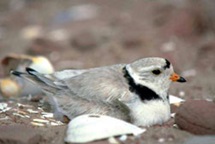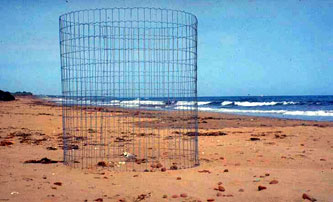page5
Piping plovers are making a comeback in Kejimkujik's Seaside Adjunct
Kejimkujik National Park and National Historic Site of Canada reduces human-induced stressors to restore and protect habitat of these endangered shorebirds
The nest of the Piping plover (Charadrius melodus) is different from many other birds. nests. These small shorebirds arrive in Atlantic Canada in late April or May and stay through the summer to breed and fledge their young. Their nests consist of small depressions in the sand, and are situated just above the high-tide line on exposed sandy or gravelly ocean beaches, sand spits or barrier beaches. The nests may contain small shells and pebbles for camouflage, making it difficult for predators and for hikers walking along the beaches to see them.
The Committee on the Status of Endangered Wildlife in Canada listed Piping plovers as "endangered" in 1985. Plover monitoring in Atlantic Canada reported 449 adult Piping plovers in 2000 (222 pairs, 5 singles), and 483 adult plovers in 2001 (220 pairs, 43 singles). It has become clear that sustaining plover habitat is a key factor in sustaining plovers. Human disturbance around breeding pairs is a major risk, as it places a great demand on the birds to defend their nests, which they do through displays. The displaying also causes them to spend time off their nests, which causes developing eggs to cool. Garbage left behind by people on the beaches also poses a risk, as it can attract the predators (crows, gulls, foxes and raccoons) that prey on the plover's eggs and young. Off-leash pets also pose a considerable threat.
A unique restoration effort is underway at the Kejimkujik Seaside Adjunct, the coastal portion of Kejimkujik National Park of Canada. While resource conservation staff have successfully controlled predators and people within plover nesting areas, the number of nesting pairs still declined from a high of 27 pairs in 1977 to just 4 pairs in 2003. Researchers noted that dense mats of vegetation (mostly Marram grass) had begun to threaten suitable plover nesting habitat. Also, in 2003, Hurricane Juan flooded and eroded a full third of the remaining favourable habitat in the Adjunct.
 Piping plover on nest © Parks Canada / J. Sylvester |
To help the Atlantic Piping plover recover, Parks Canada is collaborating with many other organizations in a National Recovery Plan for the Piping plover. Dense mats of Marram grass have been cleared to create new habitat at the Seaside Adjunct. Now in its second year, the restored habitat has helped plovers to successfully raise four chicks. As well, Kejimkujik National Park has created a new staff position that combines the role of researcher with the duties of an interpreter. This new position has raised public awareness about the plover's plight and about efforts to restore its habitat, as the public learns first-hand about the researcher's work.
Recovery team members are aiming to achieve a self-sustaining and well-distributed population of 670 adult plovers (335 pairs) within 10 years. They hope to create a habitat that will be able to sustain as many as 400 pairs and protect at least 65% of plover nesting habitat.
Results
- The plover fledging rate within Kejimkujik Seaside Adjunct has consistently met or exceeded recovery targets.
- To reduce human disturbance, sections of beaches and trails are closed to the public until chicks have fledged. Nesting areas are usually closed from early May until late July or early August.
- Plover monitors place predator exclosures around all nests to protect eggs up to the hatching stage. Made of wire mesh, the exclosures have openings large enough for adult plovers and chicks to pass through, but too small for predators. Predator exclosures within the park have led to increased hatching success and overall productivity.
- Thick mats of beach grass were removed from breeding areas in 2002 to restore an old plover breeding site. A few plovers returned to the area the following year, and in 2004, a plover pair successfully nested and fledged chicks in the area.
- A roving researcher/interpreter provides visitors with up-to-date information on the endangered bird. This information has reached 40% of all visitors to the area.
 Piping plover in a predator exclosure © Parks Canada |
- Date modified :